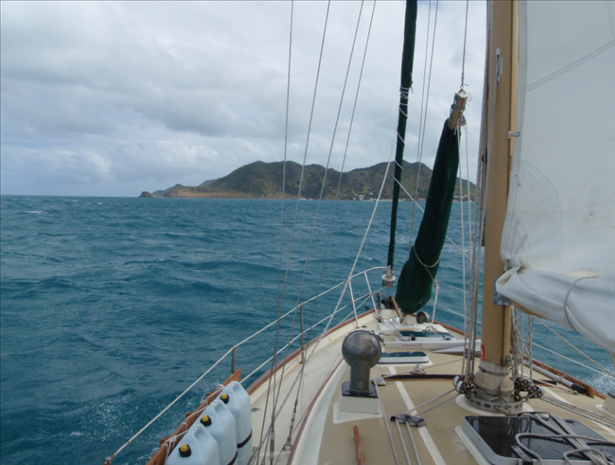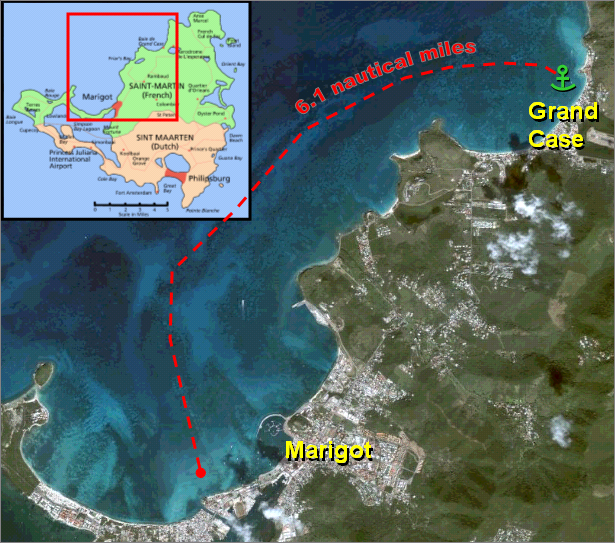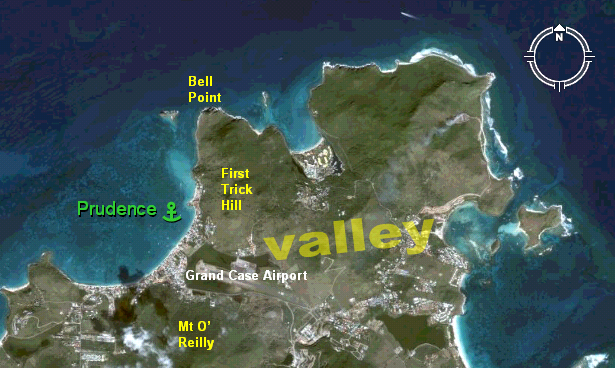

- PHOTOS:
- Dec 16, 2008 - May 21, 2009
- Mar 17, 2008 - Dec 15, 2008
- Nov 01, 2007 - Mar 16, 2008
- Our SC35 Sailboat: PRUDENCE
- SELECTED BLOGS
- Jan'05: The Idea
- May'05: First Cruise - Belize
- Aug'05: Buying Ashiya
- Oct'05: School in St. Vincent
- Nov'05: Ocracoke on Ashiya
- Jul'06: Long Trip on Ashiya
- Oct'06: Prudence Comes Home
- Nov'07: First Night Offshore
- Nov'07: Offshore Take Two
- Nov'07: Gulf Stream Crossing
- Dec'07: Green Turtle Cay
- Dec'07: Lynyard Cay
- Dec'07: Warderick Wells Cay
- Jan'08: George Town
- Jan'08: Life without a Fridge
- Jan'08: Mayaguana Island
- Jan'08: Turks & Caicos
- Jan'08: Dominican Republic
- Jan'08: Down the Waterfalls
- Feb'08: Puerto Rico
- Feb'08: Starter Troubles
- Feb'08: Vieques
- Mar'08: Finally Sailing Again
- Mar'08: Trip So Far
- Mar'08: Hiking Culebra
- Mar'08: Kayak & Snorkel I
- Mar'08: Teak and Waterspouts
- Mar'08: Kayak & Snorkel II
- Mar'08: Bottom Cleaning
- Apr'08: Culebra Social Life
- Apr'08: Culebra Routine
- Apr'08: Culebra Beaches
- Apr'08: Culebrita
- Jun'08: Kayak & Snorkel III
- Jun'08: Kayak & Snorkel IV
- Jun'08: Manta Ray
- Jun'08: Sea Turtles
- Jul'08: Cost of Cruising
- Jul'08: Busy Week in Culebra
- Jul'08: Getting to Land
- Jul'08: Leatherback Boil
- Jul'08: Fish and Volcano Dust
- Aug'08: Teaching Algebra
- Sep'08: Culebra Card Club
- Oct'08: Kayak & Snorkel V
- Oct'08: Prep for Hurricane
- Oct'08: Hurricane Omar
- Oct'08: Fish and Sea Glass
- Oct'08: Waterspouts
- Dec'08: Hurricane Season Ends
- Dec'08: Culebra to St. Martin
- Jan'09: Antigua Part 1
- Feb'09: The Saints
- Feb'09: Visiting Dominica
- Mar'09: Antigua Part 2
- Apr'09: Antigua to Bermuda
- May'09: Bermuda to Norfolk
- FULL LIST of Blog Entries
15 July 2009
14 July 2009
15 June 2009
14 June 2009 | Annapolis, MD
13 June 2009
12 June 2009
11 June 2009
10 June 2009 | Little Creek Marina, Norfolk, VA, USA
04 June 2009 | Little Creek Marina, Norfolk, VA, USA
31 May 2009 | Little Creek Marina, Norfolk, VA, USA
29 May 2009 | Little Creek Marina, Norfolk, VA, USA
26 May 2009 | Little Creek Marina, Norfolk, VA, USA
25 May 2009 | Little Creek Marina, Norfolk, VA, USA
13 May 2009 | through 21-May-2009
13 May 2009 | through 21-May-2009
12 May 2009 | St George's Town, Bermuda
11 May 2009 | St George's Town, Bermuda
07 May 2009 | St George's Town, Bermuda
04 May 2009 | St George's Town, Bermuda
21 April 2009 | through 02-May-2009
From Marigot to Grand Case
28 December 2008 | Grand Case, St. Martin

CURRENT LOCATION: Anchored in Baie de Grand Case between the town dock and Rocher Créole
18 06.408' N, 063 03.346' W
Ten days at anchor in Marigot Bay. The last half of which have been with very high winds and waves. We woke today ready for a new destination. It is time to pick up the anchors and set sail. The fact that we are not waiting until Tuesday, when the winds are predicted to come down is ample evidence that we have grown weary of the constant boat motion.
Just to give you a small example of the conditions on a constantly moving boat, take a task as simple as washing your hands. We use a foot pump to dispense water in our head sink. After a squirt of liquid soap, you massage your hands together thoroughly, then wash and rinse with hands suspended beneath the tap while your right foot pumps a small pedal (like the brake pedal in a car) to deliver a stream of water. Pretty easy, right? Well, now imagine tipping the floor 10-15 degrees, unexpectedly, while you are perched on one leg (with slippery hands, no less). Not so easy anymore. Even the Karate Kid got to practice the 'Crane Technique' from a stationary piling. To perform it on a moving boat requires more balance and coordination than I will ever possess.
So we stumbled around the topic, neither of us saying directly, "Let's move the boat." But reading between the lines of the morning conversation it was evident, we are ready. So we took the engine off the dinghy and secured it on the stern rail, stowed all items below, and started the process of gathering all of our ground tackle. It was no problem to unlash the chain from the fortress rode, but when we got to the snubber (tied to the chain with a rolling hitch and backed up with two half hitches), we were stopped in our tracks.
This half-inch three-strand snubber line had taken the bulk of the load for days, and the knot was fused solid. This is the first time in over a year of using this knot on the snubber (often for periods of over a month) that I haven't been able to untie it. Sheryl tried prying it off with a marlinspike and managed to free the half hitches, but the rolling hitch would not give. Finally, we decided to sacrifice a few feet of snubber and employed our dive knife. This is the first time we have used our Myerchin knife, and although the handle has already rusted a little too easily by simply sitting exposed to the salt air, the knife cut through that line like it was butter. It definitely makes me feel good about having that particular tool aboard, should we ever need to cut a line in an emergency situation.
By the time we got the snubber off, a squall was threatening to roll right over us. Sheryl asked if I wanted to wait and I made the executive decision to continue pulling up the anchors. Both the CQR and Fortress were on board just as the first raindrops began to fall. Sheryl steered the boat out of the bay while I secured the Fortress on the cabin top. The rain became heavy and visibility diminished such that both of us were focused on watching for other boats.
The rains soon passed, and we were able to put up a reefed mainsail to keep us a little more steady and help our little engine push us forward through the tall waves. Our destination was mostly upwind, and our engine has not had a good workout in some time, so we left it running and motorsailed with a single reef in the main the entire way to Grand Case.

Although it was a relatively short distance, it seemed to take forever to reach Grand Case. The waves were huge and the winds were screaming at up to 27-knots. With Patience in tow, poor Prudence could barely keep her speed above 2.5 knots. Eventually, we pulled into the protection of Baie de Grand Case, and the world became wonderful again. The bay was flat calm, and only a gentle breeze stirred the water. Although a little swell sneaks in, it is barely noticeable unless it approaches the boat directly on the beam. We dropped our anchor in 12 feet of water and sat back a moment to take in our surroundings.
We are anchored directly beneath First Trick Hill, which tops off at 224 meters. The airport (behind the town) sits in a valley which extends to the east side of the island. Immediately to its southeast is Mt. O'Reilly (401 meters). In addition, we are just around the corner from Bell Point near the northeast tip of the island. All this lends a beautiful backdrop to this gorgeous anchorage.

The topographical description is also intended to help provide an explanation for what are the most flukey winds we have ever experienced. Anchored here in Grand Case for just a few hours, it has been generally calm with sudden gusts of wind. Sort of a nightmare situation for a newly anchored boat, as we tend to creep up on our anchor in the calm and get pushed back with a rapid tug when the winds kick up. In addition to the sudden fluctuations of wind velocity, it also seems a roll of the cosmic dice determines the wind direction. In fact, each boat in the harbor seems to find its own wind and we are often pointing in different directions from any other boat.
The good news is that there is a reasonable amount of space between us and the surrounding boats. The bad news is that the recent days of high winds and seas have stirred up the waters such that I cannot see well enough to find our anchor and dive on it. I tried, unsuccessfully, just before sundown to follow the chain out, but it quickly becomes buried in the sand and lost. I can only hope that the anchor, too, has buried itself well. For tonight, we will just have to trust that our ground tackle will come through for us again and hold us firmly in these challenging conditions. Wish us well, dear Reader.

18 06.408' N, 063 03.346' W
Ten days at anchor in Marigot Bay. The last half of which have been with very high winds and waves. We woke today ready for a new destination. It is time to pick up the anchors and set sail. The fact that we are not waiting until Tuesday, when the winds are predicted to come down is ample evidence that we have grown weary of the constant boat motion.
Just to give you a small example of the conditions on a constantly moving boat, take a task as simple as washing your hands. We use a foot pump to dispense water in our head sink. After a squirt of liquid soap, you massage your hands together thoroughly, then wash and rinse with hands suspended beneath the tap while your right foot pumps a small pedal (like the brake pedal in a car) to deliver a stream of water. Pretty easy, right? Well, now imagine tipping the floor 10-15 degrees, unexpectedly, while you are perched on one leg (with slippery hands, no less). Not so easy anymore. Even the Karate Kid got to practice the 'Crane Technique' from a stationary piling. To perform it on a moving boat requires more balance and coordination than I will ever possess.
So we stumbled around the topic, neither of us saying directly, "Let's move the boat." But reading between the lines of the morning conversation it was evident, we are ready. So we took the engine off the dinghy and secured it on the stern rail, stowed all items below, and started the process of gathering all of our ground tackle. It was no problem to unlash the chain from the fortress rode, but when we got to the snubber (tied to the chain with a rolling hitch and backed up with two half hitches), we were stopped in our tracks.
This half-inch three-strand snubber line had taken the bulk of the load for days, and the knot was fused solid. This is the first time in over a year of using this knot on the snubber (often for periods of over a month) that I haven't been able to untie it. Sheryl tried prying it off with a marlinspike and managed to free the half hitches, but the rolling hitch would not give. Finally, we decided to sacrifice a few feet of snubber and employed our dive knife. This is the first time we have used our Myerchin knife, and although the handle has already rusted a little too easily by simply sitting exposed to the salt air, the knife cut through that line like it was butter. It definitely makes me feel good about having that particular tool aboard, should we ever need to cut a line in an emergency situation.
By the time we got the snubber off, a squall was threatening to roll right over us. Sheryl asked if I wanted to wait and I made the executive decision to continue pulling up the anchors. Both the CQR and Fortress were on board just as the first raindrops began to fall. Sheryl steered the boat out of the bay while I secured the Fortress on the cabin top. The rain became heavy and visibility diminished such that both of us were focused on watching for other boats.
The rains soon passed, and we were able to put up a reefed mainsail to keep us a little more steady and help our little engine push us forward through the tall waves. Our destination was mostly upwind, and our engine has not had a good workout in some time, so we left it running and motorsailed with a single reef in the main the entire way to Grand Case.

Although it was a relatively short distance, it seemed to take forever to reach Grand Case. The waves were huge and the winds were screaming at up to 27-knots. With Patience in tow, poor Prudence could barely keep her speed above 2.5 knots. Eventually, we pulled into the protection of Baie de Grand Case, and the world became wonderful again. The bay was flat calm, and only a gentle breeze stirred the water. Although a little swell sneaks in, it is barely noticeable unless it approaches the boat directly on the beam. We dropped our anchor in 12 feet of water and sat back a moment to take in our surroundings.
We are anchored directly beneath First Trick Hill, which tops off at 224 meters. The airport (behind the town) sits in a valley which extends to the east side of the island. Immediately to its southeast is Mt. O'Reilly (401 meters). In addition, we are just around the corner from Bell Point near the northeast tip of the island. All this lends a beautiful backdrop to this gorgeous anchorage.

The topographical description is also intended to help provide an explanation for what are the most flukey winds we have ever experienced. Anchored here in Grand Case for just a few hours, it has been generally calm with sudden gusts of wind. Sort of a nightmare situation for a newly anchored boat, as we tend to creep up on our anchor in the calm and get pushed back with a rapid tug when the winds kick up. In addition to the sudden fluctuations of wind velocity, it also seems a roll of the cosmic dice determines the wind direction. In fact, each boat in the harbor seems to find its own wind and we are often pointing in different directions from any other boat.
The good news is that there is a reasonable amount of space between us and the surrounding boats. The bad news is that the recent days of high winds and seas have stirred up the waters such that I cannot see well enough to find our anchor and dive on it. I tried, unsuccessfully, just before sundown to follow the chain out, but it quickly becomes buried in the sand and lost. I can only hope that the anchor, too, has buried itself well. For tonight, we will just have to trust that our ground tackle will come through for us again and hold us firmly in these challenging conditions. Wish us well, dear Reader.
| Vessel Name: | Prudence |
| About: |
Gallery not available

- PHOTOS:
- Dec 16, 2008 - May 21, 2009
- Mar 17, 2008 - Dec 15, 2008
- Nov 01, 2007 - Mar 16, 2008
- Our SC35 Sailboat: PRUDENCE
- SELECTED BLOGS
- Jan'05: The Idea
- May'05: First Cruise - Belize
- Aug'05: Buying Ashiya
- Oct'05: School in St. Vincent
- Nov'05: Ocracoke on Ashiya
- Jul'06: Long Trip on Ashiya
- Oct'06: Prudence Comes Home
- Nov'07: First Night Offshore
- Nov'07: Offshore Take Two
- Nov'07: Gulf Stream Crossing
- Dec'07: Green Turtle Cay
- Dec'07: Lynyard Cay
- Dec'07: Warderick Wells Cay
- Jan'08: George Town
- Jan'08: Life without a Fridge
- Jan'08: Mayaguana Island
- Jan'08: Turks & Caicos
- Jan'08: Dominican Republic
- Jan'08: Down the Waterfalls
- Feb'08: Puerto Rico
- Feb'08: Starter Troubles
- Feb'08: Vieques
- Mar'08: Finally Sailing Again
- Mar'08: Trip So Far
- Mar'08: Hiking Culebra
- Mar'08: Kayak & Snorkel I
- Mar'08: Teak and Waterspouts
- Mar'08: Kayak & Snorkel II
- Mar'08: Bottom Cleaning
- Apr'08: Culebra Social Life
- Apr'08: Culebra Routine
- Apr'08: Culebra Beaches
- Apr'08: Culebrita
- Jun'08: Kayak & Snorkel III
- Jun'08: Kayak & Snorkel IV
- Jun'08: Manta Ray
- Jun'08: Sea Turtles
- Jul'08: Cost of Cruising
- Jul'08: Busy Week in Culebra
- Jul'08: Getting to Land
- Jul'08: Leatherback Boil
- Jul'08: Fish and Volcano Dust
- Aug'08: Teaching Algebra
- Sep'08: Culebra Card Club
- Oct'08: Kayak & Snorkel V
- Oct'08: Prep for Hurricane
- Oct'08: Hurricane Omar
- Oct'08: Fish and Sea Glass
- Oct'08: Waterspouts
- Dec'08: Hurricane Season Ends
- Dec'08: Culebra to St. Martin
- Jan'09: Antigua Part 1
- Feb'09: The Saints
- Feb'09: Visiting Dominica
- Mar'09: Antigua Part 2
- Apr'09: Antigua to Bermuda
- May'09: Bermuda to Norfolk
- FULL LIST of Blog Entries





